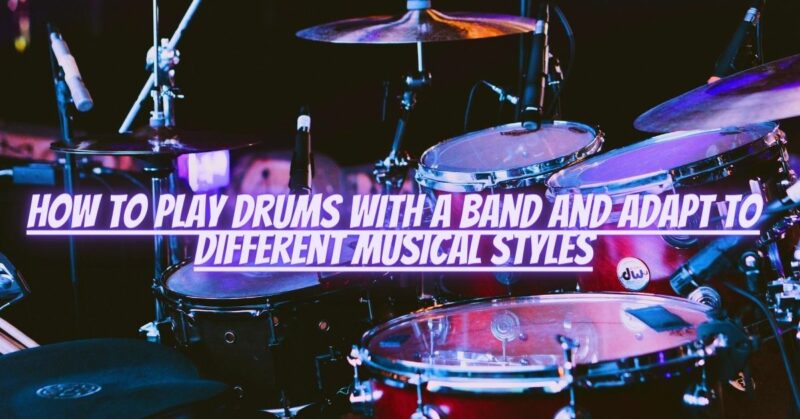Playing drums with a band requires more than just technical proficiency. It demands the ability to adapt to different musical styles and genres, allowing you to create a seamless musical experience with your bandmates. Whether you’re exploring rock, jazz, funk, or any other genre, versatility is the key to becoming a well-rounded drummer. In this article, we will explore strategies and techniques to help you play drums with a band and adapt to different musical styles, enabling you to deliver dynamic and captivating performances across diverse genres.
- Listen and Analyze: To adapt to different musical styles, immerse yourself in the sounds and nuances of each genre. Listen to a wide range of artists and bands within the specific style you’re aiming to play. Pay attention to the drumming techniques, rhythmic patterns, and overall feel of the music. Analyze the specific elements that define the genre, such as characteristic grooves, fills, and dynamics. This deep understanding will inform your playing and allow you to adapt to the specific musical style.
- Study the Masters: Identify drummers who excel in the genres you wish to explore and study their playing style. Watch live performances, instructional videos, and listen to their recordings. Pay attention to their drumming techniques, use of dynamics, and stylistic nuances. Incorporate elements of their playing into your own drumming, blending their influences with your unique musical voice.
- Master Genre-Specific Techniques: Each musical style has its own set of drumming techniques and approaches. Take the time to master these genre-specific techniques to enhance your versatility. For example, in funk drumming, focus on developing a tight and syncopated groove, utilizing ghost notes and intricate bass drum patterns. In jazz drumming, work on swing feel, brush techniques, and complex coordination patterns. By dedicating time to genre-specific techniques, you’ll be better equipped to adapt to different musical styles.
- Understand Song Structures and Arrangements: Familiarize yourself with the typical song structures and arrangements within each genre. Study the intros, verses, choruses, bridges, and instrumental breaks commonly found in songs of that style. Understand how drumming patterns and fills change throughout the song to provide dynamic shifts and support the overall structure. This understanding will enable you to adapt your drumming to fit the specific requirements of different songs within a genre.
- Experiment with Sound and Dynamics: Adapting to different musical styles involves exploring different sounds and dynamics. Experiment with different drum sounds, such as tuning your drums differently, using different drumheads, or adding dampening for specific genres. Adjust your playing dynamics to match the intensity and energy levels required in each style. Be willing to explore different stickings, cymbal choices, and auxiliary percussion to add unique flavors to your drumming in different musical contexts.
- Communicate and Collaborate: Effective communication with your bandmates is vital when adapting to different musical styles. Discuss the musical vision, arrangements, and expectations with your band. Understand each other’s musical preferences and provide input on how the drumming can best serve the style being played. Collaborate during rehearsals to experiment with different approaches and collectively shape the band’s sound within each genre.
- Develop Your Musical Vocabulary: Expand your musical vocabulary by learning and practicing various drumming patterns, grooves, and fills from different genres. Incorporate these patterns into your drumming repertoire, making them readily available when adapting to different musical styles. This versatility allows you to seamlessly transition between genres and provide appropriate drumming patterns for each style.
- Be Open to Improvisation: Different musical styles may allow for improvisation within certain sections or performances. Develop your improvisational skills by practicing soloing techniques and experimenting with different rhythmic ideas. Understand the principles of improvisation within each genre and be willing to explore creative avenues during live performances or jam sessions.
- Embrace Musicality and Feel: Beyond technique, musicality and feel are essential when adapting to different musical styles. Focus on playing with intention, connecting emotionally with the music, and supporting the overall musical expression. Develop your ability to listen to the other band members, respond to their cues, and lock in with the rhythm section. The ability to groove and connect with the music on a deeper level will greatly enhance your adaptability in different styles.
Conclusion: Playing drums with a band and adapting to different musical styles requires a combination of technical proficiency, musical knowledge, and versatility. By actively listening, studying masters of each genre, mastering genre-specific techniques, understanding song structures, experimenting with sound and dynamics, communicating with your bandmates, developing your musical vocabulary, embracing improvisation, and prioritizing musicality and feel, you can become a drummer capable of seamlessly transitioning between diverse musical styles. Embrace the challenge of adapting to different genres, and let your versatility shine as you contribute to captivating and dynamic performances with your band.


